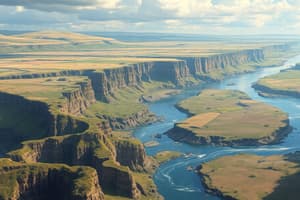Podcast
Questions and Answers
Which of the following is NOT a type of erosion involved in river valley and river channel formation?
Which of the following is NOT a type of erosion involved in river valley and river channel formation?
- Abrasion
- Solution (correct)
- Hydraulic Action
- Attrition
What is the main factor that contributes to the formation of V-shaped valleys in the upper course of a river?
What is the main factor that contributes to the formation of V-shaped valleys in the upper course of a river?
- Weathering
- Deposition
- Vertical erosion (correct)
- Lateral erosion
In which course of a river are wider and deeper valleys formed, along with the development of meanders?
In which course of a river are wider and deeper valleys formed, along with the development of meanders?
- Upper course
- All courses
- Lower course
- Middle course (correct)
What is the main factor that contributes to the formation of broad floodplains and levees in the lower course of a river?
What is the main factor that contributes to the formation of broad floodplains and levees in the lower course of a river?
Which of the following is NOT an upland landform formed by vertical erosion?
Which of the following is NOT an upland landform formed by vertical erosion?
What is the process by which eroded materials are carried downstream by a river?
What is the process by which eroded materials are carried downstream by a river?
When does deposition occur in river processes?
When does deposition occur in river processes?
Which process leads to the formation of oxbow lakes?
Which process leads to the formation of oxbow lakes?
What is the primary cause of cliff formation on the outer banks of meanders?
What is the primary cause of cliff formation on the outer banks of meanders?
What is the main factor that determines the formation of flood plains?
What is the main factor that determines the formation of flood plains?
What type of rock is typically found at the base of waterfalls?
What type of rock is typically found at the base of waterfalls?
What is the primary function of levees?
What is the primary function of levees?
What type of landform is formed by alternating erosion and deposition in a river?
What type of landform is formed by alternating erosion and deposition in a river?
What causes sediments to spread out and deposit on the adjacent land during floods?
What causes sediments to spread out and deposit on the adjacent land during floods?
What is the primary cause of the formation of slip-off slopes on the inner banks of meanders?
What is the primary cause of the formation of slip-off slopes on the inner banks of meanders?
Flashcards are hidden until you start studying
Study Notes
River Valley and Channel Formation
- River valley and channel formation involves various types of erosion, excluding weathering.
- The main factor contributing to the formation of V-shaped valleys in the upper course of a river is vertical erosion.
Middle and Lower Course of a River
- Wider and deeper valleys are formed in the middle course of a river, along with the development of meanders.
- Broad floodplains and levees are formed in the lower course of a river due to the deposition of sediment.
Upland Landforms
- A pedestal rock is not an upland landform formed by vertical erosion.
River Processes
- Eroded materials are carried downstream by a river through the process of transportation.
- Deposition occurs in river processes when the river's velocity decreases, causing sediment to settle.
Meanders and Oxbow Lakes
- The process that leads to the formation of oxbow lakes is cutoff.
- Cliff formation on the outer banks of meanders is primarily caused by erosion.
Floodplains and Levees
- The formation of floodplains is determined by the amount of sediment deposited during floods.
- Levees are primarily constructed to prevent flooding by containing the river's flow.
Waterfalls and Landforms
- Hard, resistant rock is typically found at the base of waterfalls.
- A meander belt is a type of landform formed by alternating erosion and deposition in a river.
Sediment Deposition
- Sediments spread out and deposit on adjacent land during floods due to a decrease in the river's velocity.
- Slip-off slopes on the inner banks of meanders are formed primarily due to erosion.
Studying That Suits You
Use AI to generate personalized quizzes and flashcards to suit your learning preferences.



